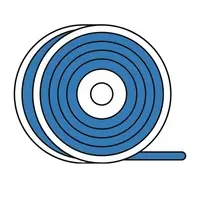CARBON Filament Print Settings & Material Information
CARBON print settings (Cura profile import, how it is done ...)
 Download Cura profile for our
Download Cura profile for our  CARBON filament.
CARBON filament.
 Here the matching 1.75mm
Here the matching 1.75mm  CARBON filaments.
CARBON filaments.
 Here the matching 2.85mm
Here the matching 2.85mm  CARBON filaments.
CARBON filaments.
 Data sheet for our
Data sheet for our  CARBON filament.
CARBON filament.
CARBON material summary
The carbon filament consists of about 70% PLA and about 30% carbon fiber.
Due to the high strength and the carbon particles contained, we recommend the use of steel nozzles with a slightly larger diameter (0.6 or 0.8mm). The usual brass nozzles will wear out quickly and clog at 0.2 or 0.4mm. Corresponding stainless steel nozzles with a larger hole diameter can be found in our shop.
PLA (Polylactic Acid) belongs to the group of synthetic polymers and is produced from regenerative sources such as corn starch or sugar cane.
Thus, PLA is a so-called "biocompatible plastic". Due to the growing environmental awareness of the population and the economy, PLA is becoming increasingly important.
The filament is characterised by its high strength, low melting temperature and virtually no warpage.
PLA is therefore particularly suitable for beginners.
CARBON advantages
CARBON disadvantages
CARBON print area (recommendations)
Since each 3D printer has its own parameter preferences, adjustments to the settings and fine-tuning are necessary to achieve optimal print results.
** depending on the printing bed adhesion method also slightly less (e.g. with BlueTape possibly 10 to 30°C less)
Spool dimensions
Compability:
Our filaments are suitable for all common 3D printers (FDM / FFF - Fused Deposition Modeling / Fused Filament Fabrication).
Nevertheless, the instructions of the printer manufacturer regarding nozzle diameter, filament material, filament diameter and coil dimensions should be observed.
Storage:
Due to the hygroscopic property (ability to bind water) of some materials, we recommend all filaments indoors to store at room temperature and of course dry. Air-tight ZIP bags or containers with the desiccant SILICA are well suited for this.
The filaments should not hang on the printer for a long time, but always be airtight when not in use and stored with sufficient SILICA sealed.
It is also recommended to dry the filament (especially NYLON and PVA materials) before use (see section "Drying")
Desiccation (drying):
Due to the temperature differences on the transport route or through the storage itself, air may have sneaked into the packaging film. Often, the material may have absorbed some moisture between the manufacturing process and sealing (NYLON and PVA are extremely hygroscopic).
Therefore, we recommend drying overnight in a dehydrator (vegetable dryer) or a few hours in a convection oven (filament and coil only, without foil).
SPECIALTY with transparent colors!
Low humidity has no or hardly any effect on "colored" filaments, only with transparent filaments, some moisture can already lead to cloudiness.
A table with common drying times and temperatures per material is attached. A lump-sum duration for the drying is not to call. Because it depends on how much moisture the filament has already pulled.
A test pressure before drying should serve as the starting point.
The drying time should be tested with about 100g of filament, which has previously separated from the coil. So we say 3x 100g filament in the oven, the first takes after 30 min, the second after 60 min and the third after 120 min out. Afterwards you make another test print with each part. The experiences made can then be transferred to the entire coil. Or if you are not in a hurry, the filament roll in a dehydrator (vegetable dryer) for a few days should also lead to the desired success.
ABS at 50°C to 80°C approx. 4h* with circulating air
PETG at 50°C to 80°C approx. 4h* with circulating air
NYLON at 60°C to 80°C approx. 8h* with circulating air
PVA at 60°C to 80°C approx. 8h* with circulating air
* Drying time varies depending on the degree of moisture in the filament and environmental influences.
It should also be noted whether the coil will withstand the temperature you have chosen.
 CARBON filament.
CARBON filament. CARBON filaments.
CARBON filaments.  CARBON filaments.
CARBON filaments.  CARBON filament.
CARBON filament.
The carbon filament consists of about 70% PLA and about 30% carbon fiber.
Due to the high strength and the carbon particles contained, we recommend the use of steel nozzles with a slightly larger diameter (0.6 or 0.8mm). The usual brass nozzles will wear out quickly and clog at 0.2 or 0.4mm. Corresponding stainless steel nozzles with a larger hole diameter can be found in our shop.
PLA (Polylactic Acid) belongs to the group of synthetic polymers and is produced from regenerative sources such as corn starch or sugar cane.
Thus, PLA is a so-called "biocompatible plastic". Due to the growing environmental awareness of the population and the economy, PLA is becoming increasingly important.
The filament is characterised by its high strength, low melting temperature and virtually no warpage.
PLA is therefore particularly suitable for beginners.
CARBON advantages
- PLA with approx. 30% carbon fibre
- high strength
- strong loading capacity
- very tough, good hardness
- hardly any warping/warping
- ideal printing characteristics
CARBON disadvantages
- Particles are abrasive -> brass nozzles could wear out faster -> stainless steel nozzles are recommended
- moderate temperature and weather resistance
CARBON print area (recommendations)
| Print temperature: | 190°C | to | 230°C |
| Print bed temperature:** | 60°C | to | 80°C |
| Print speed: | 30mm/s | to | 60mm/s |
| Travel speed: | 40mm/s | to | 100mm/s |
Since each 3D printer has its own parameter preferences, adjustments to the settings and fine-tuning are necessary to achieve optimal print results.
** depending on the printing bed adhesion method also slightly less (e.g. with BlueTape possibly 10 to 30°C less)
Spool dimensions
| Z3D 3D-Drucker-Filament.de |
1kg (net) | 0,5kg (net) |
| Outer Ø: | 200mm | 200mm |
| Inne hole: | 53mm | 53mm |
| Thickness: | 65mm | 38mm |
| eSun | 1kg (net) | 0,5kg (net) |
| Outer Ø: | 200mm | 200mm |
| Inner hole: | 52mm | 52mm |
| Thickness: | 70mm | 42mm |
General information about our filaments
Compability:
Our filaments are suitable for all common 3D printers (FDM / FFF - Fused Deposition Modeling / Fused Filament Fabrication).
Nevertheless, the instructions of the printer manufacturer regarding nozzle diameter, filament material, filament diameter and coil dimensions should be observed.
Storage:
Due to the hygroscopic property (ability to bind water) of some materials, we recommend all filaments indoors to store at room temperature and of course dry. Air-tight ZIP bags or containers with the desiccant SILICA are well suited for this.
The filaments should not hang on the printer for a long time, but always be airtight when not in use and stored with sufficient SILICA sealed.
It is also recommended to dry the filament (especially NYLON and PVA materials) before use (see section "Drying")
Desiccation (drying):
Due to the temperature differences on the transport route or through the storage itself, air may have sneaked into the packaging film. Often, the material may have absorbed some moisture between the manufacturing process and sealing (NYLON and PVA are extremely hygroscopic).
Therefore, we recommend drying overnight in a dehydrator (vegetable dryer) or a few hours in a convection oven (filament and coil only, without foil).
SPECIALTY with transparent colors!
Low humidity has no or hardly any effect on "colored" filaments, only with transparent filaments, some moisture can already lead to cloudiness.
A table with common drying times and temperatures per material is attached. A lump-sum duration for the drying is not to call. Because it depends on how much moisture the filament has already pulled.
A test pressure before drying should serve as the starting point.
The drying time should be tested with about 100g of filament, which has previously separated from the coil. So we say 3x 100g filament in the oven, the first takes after 30 min, the second after 60 min and the third after 120 min out. Afterwards you make another test print with each part. The experiences made can then be transferred to the entire coil. Or if you are not in a hurry, the filament roll in a dehydrator (vegetable dryer) for a few days should also lead to the desired success.
Drying times (recommendations):
PLA at 40°C to 50°C approx. 4h* with circulating airABS at 50°C to 80°C approx. 4h* with circulating air
PETG at 50°C to 80°C approx. 4h* with circulating air
NYLON at 60°C to 80°C approx. 8h* with circulating air
PVA at 60°C to 80°C approx. 8h* with circulating air
* Drying time varies depending on the degree of moisture in the filament and environmental influences.
It should also be noted whether the coil will withstand the temperature you have chosen.
